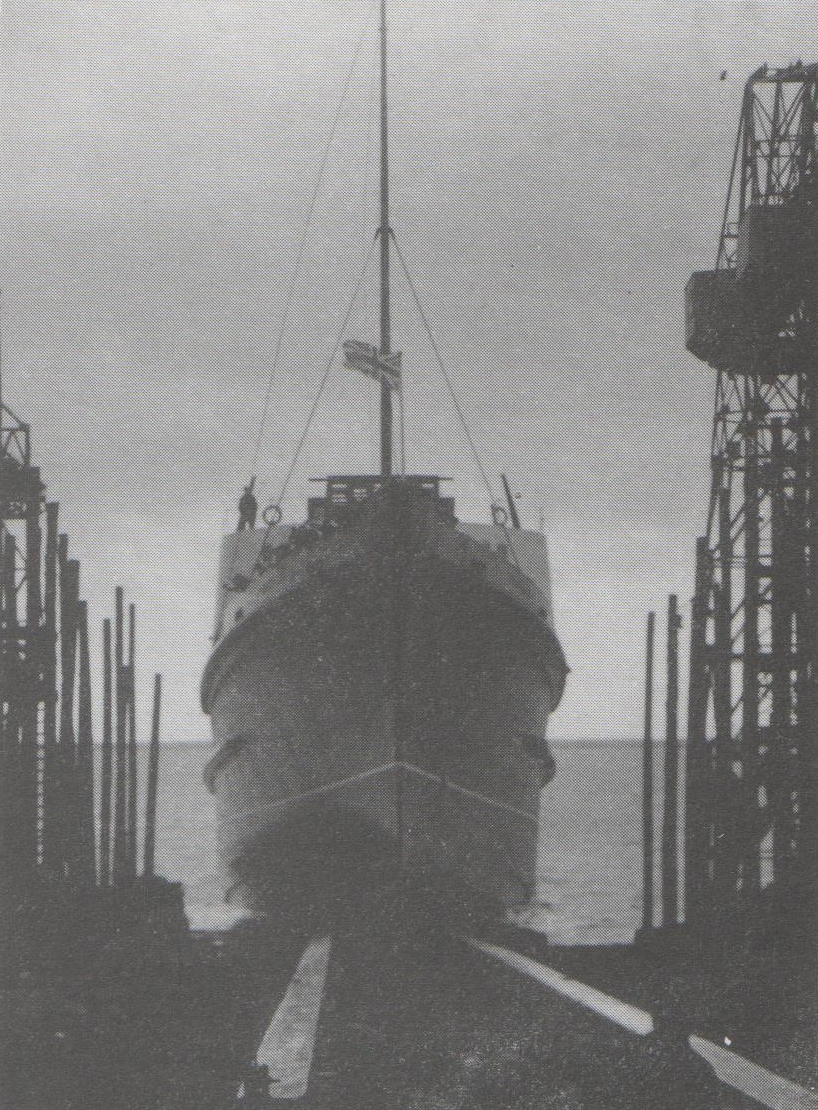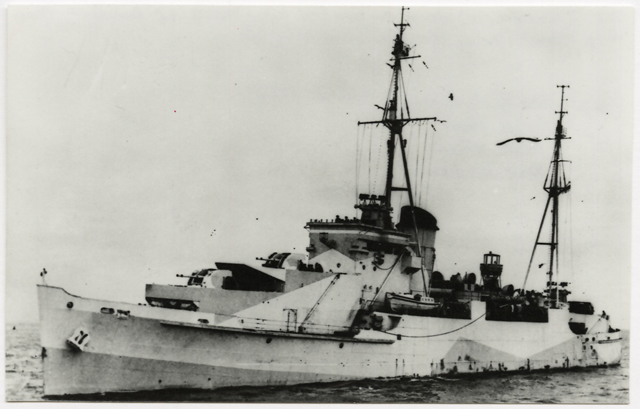SS Tynwald (1936) on:
[Wikipedia]
[Google]
[Amazon]
TSS (RMS) ''Tynwald'' No. 165281 was a passenger vessel which served with the Isle of Man Steam Packet Company from 1937 until she was requisitioned for war service at the end of 1940. She was the fourth ship in the line's history to bear the name. ''Tynwald'' was sunk in November 1942 off the coast of French North Africa.



Design and construction
''Tynwald'' and her identical twin ''Fenella'' were built by Vickers Armstrong at Barrow-in-Furness and launched on the same day, 16 December 1936. ''Tynwald'' had a gross registered tonnage of 2376t, a beam of 46', a length of 314'6", a draught of 18' and a design speed of 21 knots. Both ''Tynwald'' and ''Fenella'', had crew accommodation for 68, and a capacity for 1968 passengers. Whilst the twins were identical in almost every facet, there were two subtle differences incorporated into their external appearance so as to be able to differentiate between the two. The ''Fenella'' had a yard running out from her foremast which had been installed specifically so as she could be identified from a distance. The strake, or gunwale, around the main deck was black on the ''Fenella'' whilst it was white on the ''Tynwald.'' The bows on both ships bore not only their names but the Three Legs of Man symbol. There were also some quite distinctive differences in the interal decor of the twins. In the first class dining saloon of the ''Tynwald'' the woodwork wasQueensland walnut
''Endiandra palmerstonii'', popularly known as Queensland walnut or black walnut, is a rainforest tree of northern Queensland. It was named after the Australian prospector Christie Palmerston.
Queensland walnut has been used as a furniture timbe ...
, whilst on the ''Fenella'' it consisted of English chestnut
The chestnuts are the deciduous trees and shrubs in the genus ''Castanea'', in the beech family Fagaceae. They are native to temperate regions of the Northern Hemisphere.
The name also refers to the edible nuts they produce.
The unrelat ...
. In the first class lounge of the ''Tynwald,'' figured chestnut provided the setting for a colour scheme in green and gold whereas the ''Fenalla's'' first class lounge was panalled in Australian walnut, the general colour scheme being in blue and fawn.
The smoke room panelling was oak in the ''Tynwald'' and walnut in the ''Fenella.'' In addition the third class ladies lounge the walls were panalled with white sycamore in the ''Tynwald'' and weathered sycamore in the ''Fenella.''
Steam Packet Company service
Like her sister ship ''Fenella'', ''Tynwald'' was intended primarily to be used on the winter service between Liverpool andDouglas
Douglas may refer to:
People
* Douglas (given name)
* Douglas (surname)
Animals
*Douglas (parrot), macaw that starred as the parrot ''Rosalinda'' in Pippi Longstocking
*Douglas the camel, a camel in the Confederate Army in the American Civil W ...
.
They were virtually identical apart from slight decorative differences, the noticeable external difference being ''Tynwald'' had her upper strake painted white, whereas on ''Fenella'' it was black. Spacious lounges were a feature of both ships which were furnished to a high standard.
On 1 October 1937, the ''Tynwald'' conveyed the newly appointed Lieutenant Governor of the Isle of Man, Vice Admiral Leveson-Gower from Liverpool to Douglas
Douglas may refer to:
People
* Douglas (given name)
* Douglas (surname)
Animals
*Douglas (parrot), macaw that starred as the parrot ''Rosalinda'' in Pippi Longstocking
*Douglas the camel, a camel in the Confederate Army in the American Civil W ...
.Peel City Guardian; Date:9 Oct 1937 The ''Tynwald'' was decorated with bunting and flew the Governor's flag from the foremast. She arrived into Douglas at 14:45hrs, signalling her arrival by the blowing of her ship's whistle, which in turn was greeted by rockets being fired from Douglas Head and the sounding of the fog horn
A foghorn or fog signal is a device that uses sound to warn vehicles of navigational hazards such as rocky coastlines, or boats of the presence of other vessels, in foggy conditions. The term is most often used in relation to marine transport. W ...
on the Victoria Pier.
On 17 November 1937, during a storm with associated south-easterly gales, ''Tynwald'' sustained damage whilst attempting to berth at Douglas. Earlier that day, her sister ''Fenella'' had fouled a mooring rope whilst also attempting to berth at Douglas, which prior to the construction of the Princess Alexandra Pier in 1984, was a notoriously hazardous port due to its exposure during periods of strong easterly wind. Taking that morning's sailing from Liverpool to Douglas, ''Tynwald'' experienced great difficulty trying to berth at the King Edward VIII Pier, and suffered damage to the belting on her starboard side
Port and starboard are nautical terms for watercraft and aircraft, referring respectively to the left and right sides of the vessel, when aboard and facing the bow (front).
Vessels with bilateral symmetry have left and right halves which are ...
, over a distance of approximately five metres, as well as suffering damage to her plating.Peel City Guardian; Date:20 Nov 1937; Section:Front page; Page Number:1
Finally she secured alongside and having discharged her passengers and mail, ''Tynwald'' departed for Liverpool at 15:50hrs taking the passengers and mail which should have left on ''Fenella''s morning sailing, which had been cancelled due to her incident with the mooring rope.
War service
Along with ''Fenella'', ''Tynwald'' was requisitioned as a personnel vessel in the first week of the war. Her log was largely uneventful until with the German onslaught on Belgium and France during the spring of 1940, the plight of the British Expeditionary Force became apparent, and she was dispatched to assist with the evacuation of troops fromDunkirk
Dunkirk (french: Dunkerque ; vls, label=French Flemish, Duunkerke; nl, Duinkerke(n) ; , ;) is a commune in the department of Nord in northern France.
During the course of Operation Dynamo, ''Tynwald'', initially under the command of Captain J H Whiteway, and then under Captain W A Qualtrough, had the distinction of embarking more troops that any other company vessel.
She made her first mission to the shattered port on 28 May, and was one of ten personnel ships that lifted a total of 14,760 troops from the eastern mole the following day. The same day, her sister ''Fenella'' was lost.
In the late evening of 30 May, she was one of four personnel vessels back at the mole and withdrew 1,153 troops. On 2 June, she made her third trip and embarked 1,200 troops, leaving for
 At the end of 1940, she was compulsorily acquired, fitted out as an auxiliary anti-aircraft ship and commissioned as HMS ''Tynwald'' on 1 October 1941. Armed with 6 4-inch AA guns (3x2), and eight 2-pdr (40mm) AA guns (2x4). After a year on convoy escort duties around Britain she was assigned to
At the end of 1940, she was compulsorily acquired, fitted out as an auxiliary anti-aircraft ship and commissioned as HMS ''Tynwald'' on 1 October 1941. Armed with 6 4-inch AA guns (3x2), and eight 2-pdr (40mm) AA guns (2x4). After a year on convoy escort duties around Britain she was assigned to
Dover
Dover () is a town and major ferry port in Kent, South East England. It faces France across the Strait of Dover, the narrowest part of the English Channel at from Cap Gris Nez in France. It lies south-east of Canterbury and east of Maidstone ...
in the early morning of 3 June.
The last day of the operation was 4 June; shortly after 14:00hrs, the Admiralty
Admiralty most often refers to:
*Admiralty, Hong Kong
* Admiralty (United Kingdom), military department in command of the Royal Navy from 1707 to 1964
*The rank of admiral
* Admiralty law
Admiralty can also refer to:
Buildings
*Admiralty, Tr ...
announced that Operation Dynamo was over. By then ''Tynwald'' had already left the eastern mole after her fourth trip. She was the last ship to leave, landing 3,000 French troops in England later that day. Her total in the operation is officially given as 8,953 troops.
Royal Navy service - HMS ''Tynwald''
 At the end of 1940, she was compulsorily acquired, fitted out as an auxiliary anti-aircraft ship and commissioned as HMS ''Tynwald'' on 1 October 1941. Armed with 6 4-inch AA guns (3x2), and eight 2-pdr (40mm) AA guns (2x4). After a year on convoy escort duties around Britain she was assigned to
At the end of 1940, she was compulsorily acquired, fitted out as an auxiliary anti-aircraft ship and commissioned as HMS ''Tynwald'' on 1 October 1941. Armed with 6 4-inch AA guns (3x2), and eight 2-pdr (40mm) AA guns (2x4). After a year on convoy escort duties around Britain she was assigned to Operation Torch
Operation Torch (8 November 1942 – Run for Tunis, 16 November 1942) was an Allies of World War II, Allied invasion of French North Africa during the Second World War. Torch was a compromise operation that met the British objective of secu ...
, the Allied landing in North Africa, and was involved in the attack on Algiers
Algiers ( ; ar, الجزائر, al-Jazāʾir; ber, Dzayer, script=Latn; french: Alger, ) is the capital and largest city of Algeria. The city's population at the 2008 Census was 2,988,145Census 14 April 2008: Office National des Statistiques ...
on 8 November 1942.
Three days later the ship was part of a task force sent to capture an airfield near Bougie (modern Béjaïa) 100 miles east of Algiers. At the centre of the force were infantry landing craft, and the covering force included the cruiser , the monitor , ''Tynwald'' and fourteen other supporting vessels. The first landing met with little or no opposition, and the Bougie harbour was occupied. However, it proved impossible to capture the airfield from the sea owing to adverse weather conditions. Instead, the attacking force that was still at sea came under heavy enemy air attack in the Battle of Béjaïa.
Fate
On 12 November 1942, ''Tynwald'' was hit by a torpedo fired by the Italian submarine . She had been standing by the monitor ''Roberts'', which was on fire and badly damaged. ''Tynwald'' went down in of water, her wreck position is given as LAT:36°51'N LON:005°04'E. Survivors were rescued by ''Roberts'' and the corvette HMS ''Samphire''. Three officers and seven ratings were listed as casualties.Footnotes
{{DEFAULTSORT:Tynwald (1936) Ferries of the Isle of Man Ships of the Isle of Man Steam Packet Company Ships sunk by Italian submarines World War II shipwrecks in the Mediterranean Sea 1936 ships Ships built in Barrow-in-Furness Steamships of the United Kingdom Maritime incidents in November 1942 Auxiliary anti-aircraft ships of the Royal Navy